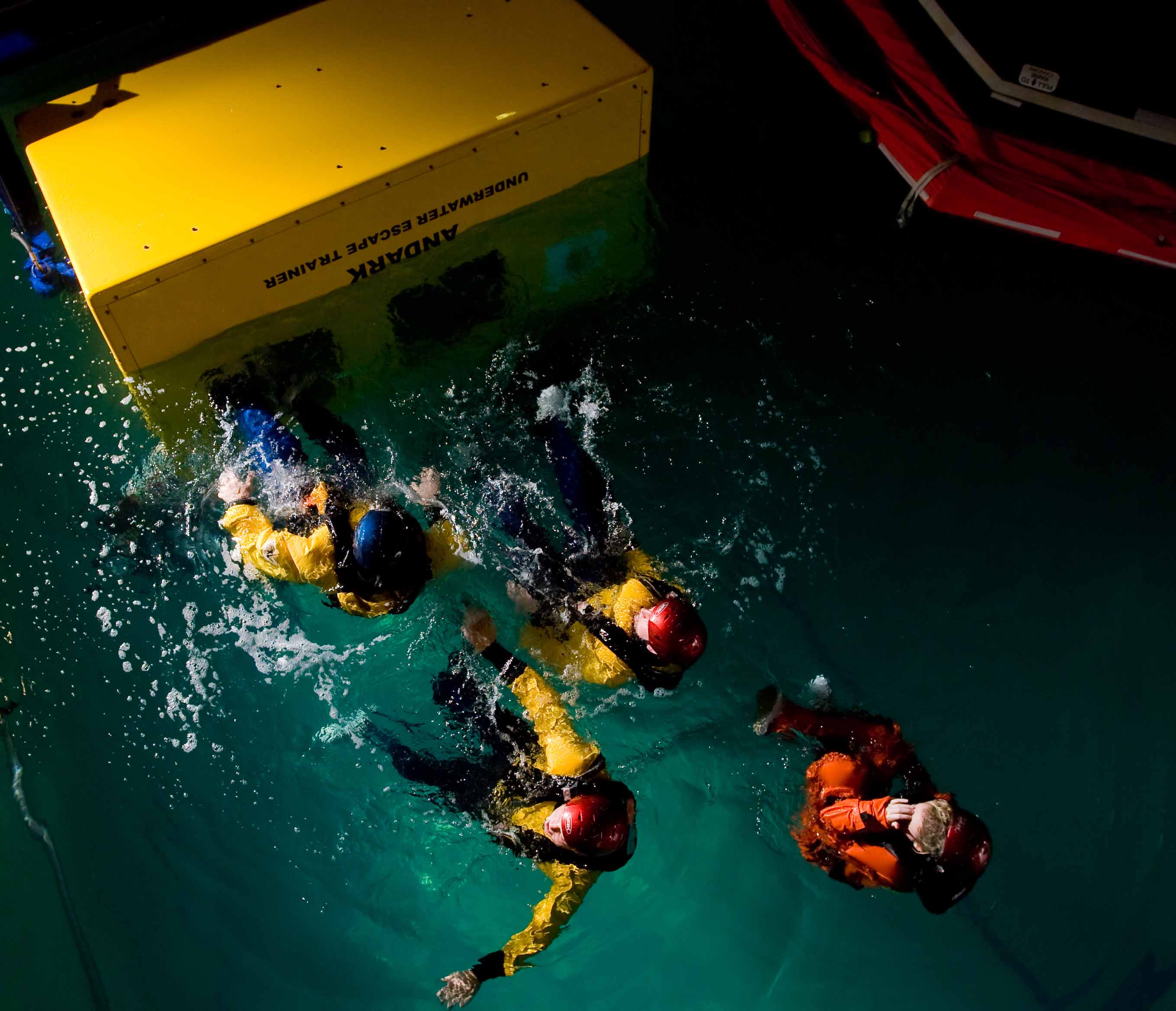Underwater escape plays an important role in safe helicopter operations. The industry has been placing increased focus on this subject and operators need to know the best practices for helicopter underwater escape training (HUET). We reached out to industry experts to consider the different factors affecting helicopter escape, the main training items and best practices for HUET, modes for training delivery, and areas for future safety improvements.
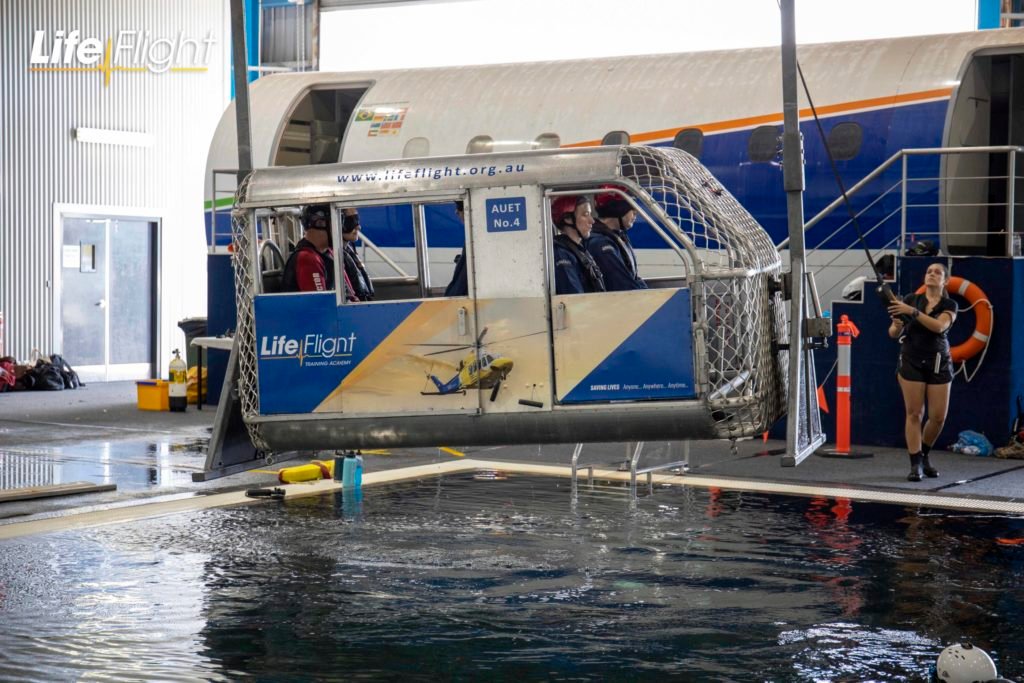
There are various factors that may impede escape to a place of relative safety – normally a life raft. These can be anthropometric, physiological, and psychological. According to Terry Crownover, director of the University of Louisiana’s Marine Survival Training Center, when it comes to fatality cause factors, it is important to start from the definition of ‘injury’, i.e., the contact with aircraft on ditching, flying debris inside aircraft, and personnel striking each other during the ditch. “Good brace-for-impact will reduce some of these injuries,” he says.
When a helicopter crashes into water, it will likely roll over and water, fuel, oil, and debris will begin to rush in, observes Mick Dowling, HUET manager at LifeFlight Training Academy.
“Sinking can occur at any time, often to depths incompatible with survival. Disorientation, confusion, panic, loss of vision, loss of balance, loss of physical reference, false perception or orientation, and in some parts of the world, the effects of extreme cold, are all factors that the occupants may encounter and must overcome for a successful egress from the submerged helicopter,” he says. “[Even] after a successful egress, the survivors may still find themselves in a potentially hostile marine environment, often possessing few or no skills to ensure continued survival.”
Crownover observes that in case of contact with water, both “disorderly evacuation” and “underwater disorientation” can occur. “Disorderly evacuation means that everybody is trying to egress through the same exit, while underwater disorientation means that the rotation of the body underwater and loss of gravitational references makes disorientation inevitable for survivors prior to escape from an inverted sunken helicopter,” he explains.
In-rushing water has four serious effects, all of which can lead to drowning. “The first effect is panic since the person is exposed to potential drowning,” says Crownover. “The second is uncontrolled hyperventilation and reduction in breath-holding ability. The third is movement in the seat, which may lead to intense disorientation. A fourth effect is an exaggeration of the first two – that of immersion in cold water. If the water is below 10° C/50° F and the survivor is not wearing a protective suit, the chance of drowning is enhanced through a combination of panic, hyperventilation, reduced breath-holding ability, and the development of cardiac arrest or arrythmia.”
Limited vision also inhibits an ability to gain direction, Crownover notes. “Added to the effects of in-rushing water, disorientation, and darkness are the effects of buoyancy once the harness buckle is released. Except for those who are very agile, comfortable underwater and practiced at escape, the buoyancy may indeed be of such a high value that it slows down or even prevents the survivor making an escape.”
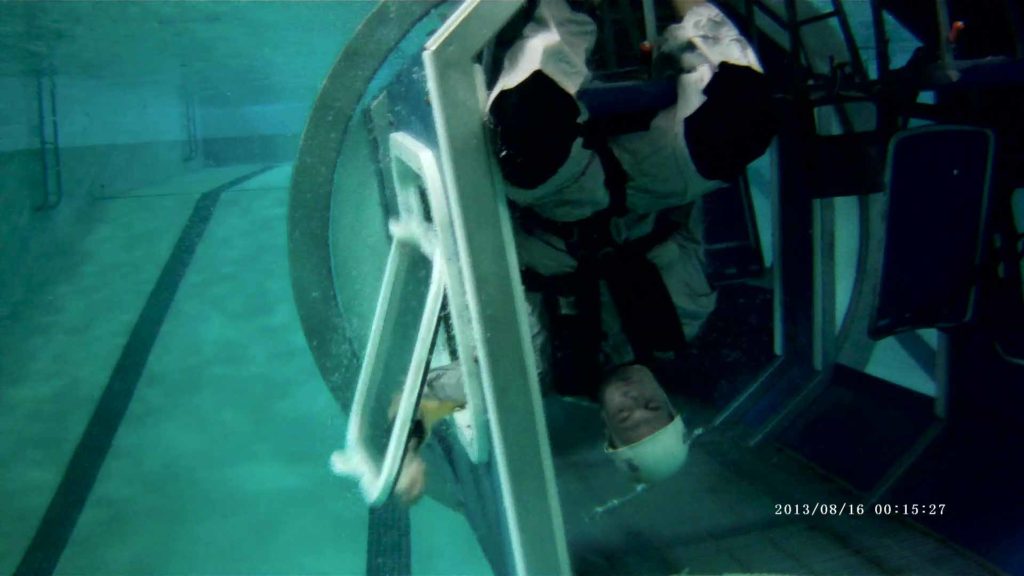
Survivors are likely to run out of air while submerged, upside down, attempting to release the restraint harness, untangle from the headset, and then move toward an escape path through debris, broken seats, and disoriented passengers, affirms Crownover. “To make a successful underwater escape, it is essential that the survivor be able to hold his/her breath or use a compressed air emergency breathing device. In cold water it is difficult to hold a breath for any given time.”
The most common reason why personnel die in survivable accidents is injury before escape, he says. “Death is principally from contact injuries rather than acceleration injuries by a ratio of 5:1. The adoption of a good crash position can increase the survival rate by reducing the strike envelope of the arms, legs, and head on cabin contents. The stabilization of the survivor in the seat is important to minimize the disorientation during and immediately post-crash, particularly during an accident with smoke and/or fire, or with sudden in-rushing water or darkness in sinking helicopters.”
Despite their difficulties, Crownover believes survival suits and life rafts are worth considering. “For the immersion suit to be universally acceptable, it must be comfortable under a wide range of ambient temperatures, easy to put on and take off, durable, simple to operate, and cheap and easy to maintain,” he notes. “During an immersion and until subsequent rescue, it must effectively slow down the hypothermia process.
“As to life rafts, anyone who has attempted to escape from an inverted, rapidly sinking helicopter or from an escape trainer would understand that while completely submerged and holding one’s breath in darkness, it is challenging to go in a direction opposite to that of the escape route to attempt to release and deploy a life raft,” he adds. “It is a simple fact that deployment of an internally carried life raft from an inverted submerged helicopter is a challenge.”
Train to survive
Training is the most common means to address the hazards associated with helicopter underwater escape. According to Jim Cunningham, Safety Training Manager at Solent University’s Warsash Maritime School, there are some important principles followed by HUET training centers for the development and delivery of training.
“These include effective brace positioning to avoid/minimize injury during a survivable impact, as well as subsequent actions after impact to locate the nearest exit point with the closest hand and while using the other hand to locate the seat buckle,” he explains. “Other important principles include the timely ejection of jettisonable exits and use of emergency breathing systems (EBS), which enable breathing underwater in a submerged passenger cabin and thus improve chances of egress in a real incident – particularly in circumstances of cold-water submersion.”
In circumstances with in-rushing water, fire, smoke, fuel, and darkness with no visual reference, one of the most significant difficulties is releasing the restraint harness and finding and releasing an escape hatch, Crownover affirms.
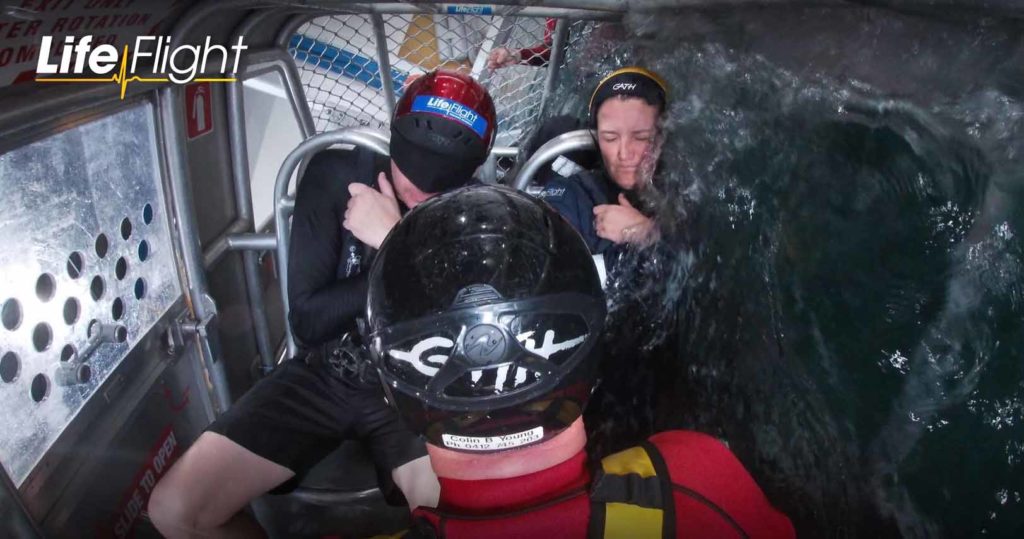
“Other factors that must be described are the problems of inevitable disorientation, the potential for being hampered by equipment, cold, injury, being pinned, being blocked by other passengers, and finally, reduced breath-holding ability, particularly in cold water,” he says. “To complete this first classroom period, a description of the hazards that may occur after a successful underwater escape should be given, particularly the very real dangers of drowning, hypothermia, and potential injury that may occur during the rescue phase.”
It is also important to teach about personal equipment, and specifically the immersion or survival suit, how it should be worn, donning and doffing procedures, and the importance of good care. Instruction should also include the principles of the life preserver, its inspection and how it is operated, breathing devices, and functional use of other equipment such as knives, flashlights, and flares, Crownover adds.
Best practice requires that training providers have access to helicopter underwater training modules that replicate, as close as possible, the operation of the aircraft’s doors, windows, hatches and exit systems, Dowling emphasizes. “Disorientation is considered one of the biggest reasons why occupants, who survive the impact of a helicopter ditching, then fail to egress because of the extended time taken to efficiently locate and operate the exit systems. When trainees have access to high-fidelity training modules, those instinctive escape skills can be developed more rigorously and accurately.”
Make it real
At the LifeFlight Training Academy, HUET is delivered by industry experts instructing on all elements of the training. “Programs should provide education and training on all aspects of survival in a marine environment to improve the outcome for the individual,” says Dowling.
Training on underwater egress without emergency breathing apparatus must be conducted using some form of helicopter underwater escape trainer, affirms Crownover. “In addition to two instructors, a minimum of two safety divers should always be required in the pool during the training sessions. Following the practical demonstration of how to abandon the helicopter, first in the upright surface position and then in the inverted position, the students must each demonstrate that they can successfully conduct the procedure themselves and then deploy all their safety equipment at the surface.”
To ensure a thorough familiarization of the equipment and procedures before attempting an abandonment in the inverted position, it is important that each student completes a minimum of two surface abandonments, says Crownover.
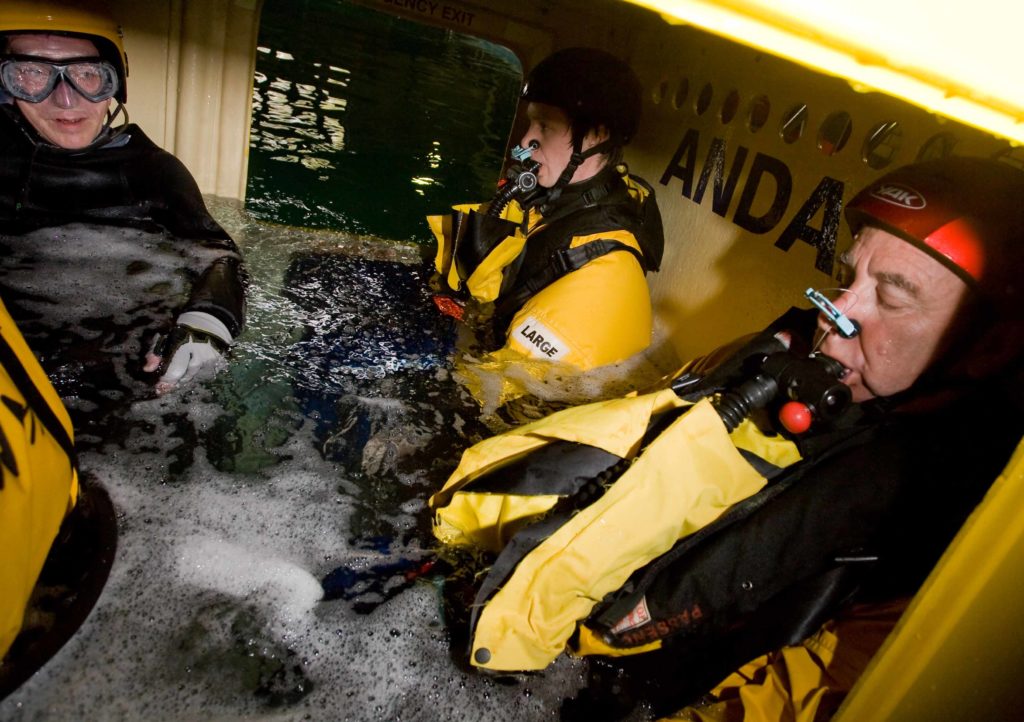
“The number of sequences that should be conducted in the inverted position will depend on the type of helicopter and the type of operation. As a minimum, it is recommended that students be required to egress successfully from the helicopter configured to the type in which they will operate or, if a passenger, in which they will most likely travel.”
To achieve qualification, students should successfully complete a minimum of four unassisted escapes, in sequence, from the designated position, he suggests. “Additional training using secondary escape routes in the underwater escape trainer can also be added if desired. The complexity of the escape can be enhanced by the addition of requirements to release life rafts and emergency locator transmitters before escape. This will all depend on the requirement of each helicopter operator.”
Recognized training providers are continually working to improve HUET outcomes by delivering training with simulators that replicate, as closely as possible, the helicopters their clients use, says Dowling. “Pilots, crew and frequent overwater fliers need to possess an ‘instinctive escape’ skillset so when the time comes, they can locate and operate the exit systems, and survive the impact.”
According to Crownover, HUET should be mandatory for all aircrews and, whenever possible, for passengers flying overwater operations. “Included in this should be the practical demonstration of the correct crash positions to adopt. If an emergency breathing system is part of the equipment, the practical use of it should be included in the training using a Shallow Water Escape Trainer,” he says.
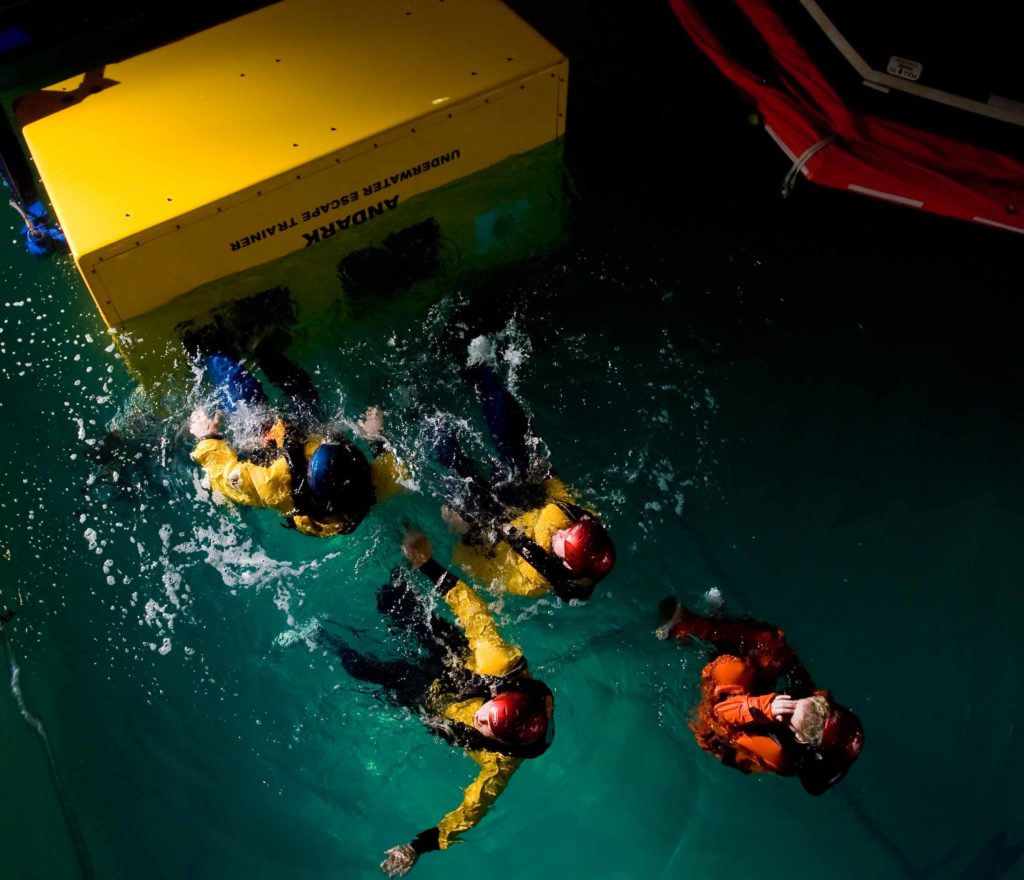
Improvements to life support equipment should be considered. “Compressed air emergency breathing apparatus should be carried by crew and passengers,” Crownover suggests.





